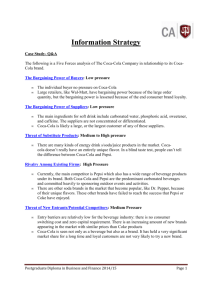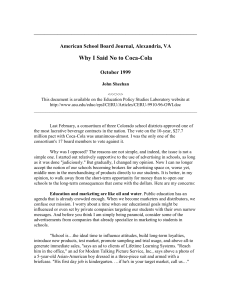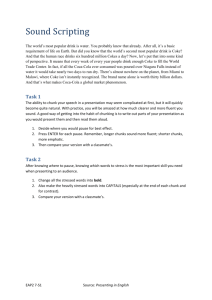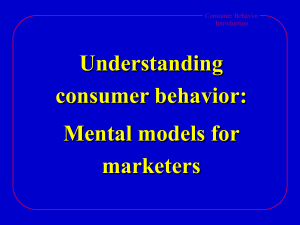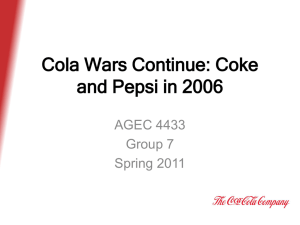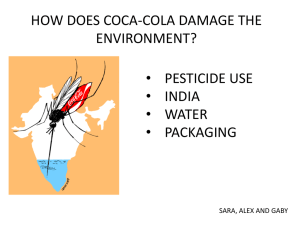Hannan Coca-Cola Situation Analysis Introduction Coca
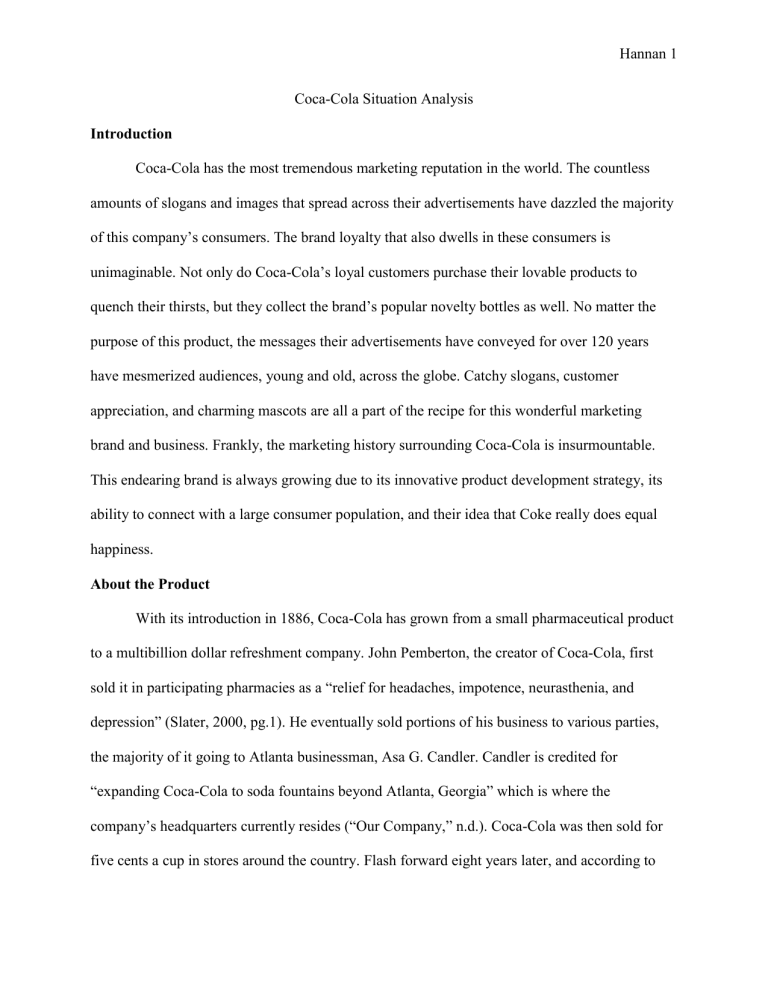
Hannan 1
Coca-Cola Situation Analysis
Introduction
Coca-Cola has the most tremendous marketing reputation in the world. The countless amounts of slogans and images that spread across their advertisements have dazzled the majority of this company’s consumers. The brand loyalty that also dwells in these consumers is unimaginable. Not only do Coca-Cola’s loyal customers purchase their lovable products to quench their thirsts, but they collect the brand’s popular novelty bottles as well. No matter the purpose of this product, the messages their advertisements have conveyed for over 120 years have mesmerized audiences, young and old, across the globe. Catchy slogans, customer appreciation, and charming mascots are all a part of the recipe for this wonderful marketing brand and business. Frankly, the marketing history surrounding Coca-Cola is insurmountable.
This endearing brand is always growing due to its innovative product development strategy, its ability to connect with a large consumer population, and their idea that Coke really does equal happiness.
About the Product
With its introduction in 1886, Coca-Cola has grown from a small pharmaceutical product to a multibillion dollar refreshment company. John Pemberton, the creator of Coca-Cola, first sold it in participating pharmacies as a “relief for headaches, impotence, neurasthenia, and depression” (Slater, 2000, pg.1). He eventually sold portions of his business to various parties, the majority of it going to Atlanta businessman, Asa G. Candler. Candler is credited for
“expanding Coca-Cola to soda fountains beyond Atlanta, Georgia” which is where the company’s headquarters currently resides (“Our Company,” n.d.). Coca-Cola was then sold for five cents a cup in stores around the country. Flash forward eight years later, and according to
Hannan 2
Coca-Cola’s official website, Joseph Biedenharn was the first to be credited with actually bottling this addictive drink. However, in 1899 “three businessmen in Tennessee secured exclusive rights to bottle and sell Coke” (“Our Company,” n.d.). This refreshing beverage could now be shipped easier and more efficiently than before which definitely impacted the profits for this booming company. Finally, in 1916, the famous contour bottle shape was created and eventually trademarked by the Coca-Cola Company in 1977. The bottle has been tweaked throughout the years but there is no mistaking this products classic and curvy shape.
Brand Image
Coca-Cola’s brand image differentiates itself from its competitors because people all over the world can recognize this extremely popular soft drink. The momentum of Coke has always been steady and “the brand promises the same experience around the world: refreshment, fun and good times” (Samadi pg.1). Their brand exudes happiness and conveys a product that is full of life; a life that is brimming with excitement and surprises. Their use of global marketing has been able to build brand love in consumers of all ages. This is why Coca-Cola has always been so successful; this brand does not discriminate against demographics whether that is size, shape, color, or age. While Coca-Cola is a successful company, they never let that go to their head and that is exemplified in their nurturing nature with their loyal customers.
Hannan 3
Consumer
Coca-Cola’s consumers consist of audiences of all ages, from the new hipster generation to the older traditional generation. However, the company’s recent advertisements have been targeting the younger population due to the rise of competition in the refreshment market.
According to Slater (2000) “thousands of new products are introduced every year, providing consumers more alternatives to currently purchased products” (pg.1). Coke does not need to penetrate the older generation with marketing techniques because their brand is already wellknown. Their advertising is also known globally and “depends heavily on tradition” (“Our
Company,” n.d.).
There are brand loyal consumers that always crave the refreshing taste of Coca-Cola every day, and there are also those consumers who strive to find the valuable collectors pieces from this famous brand. Coke has a huge collector following because “this brand has managed to build a strong company image and brand preference” (Ahanijan et. al, 2012, pg.10). This is one of the oldest and largest brand collectible industries in the world and even has an environment for consumers to share their collecting passion. The Coca-Cola Collector’s Club provides “fun shopping environments, information sources, competitors, and socialization” (Slater, 2000, pg.2).
Coca-Cola’s advertising targets every audience across the world. The innovation and happiness this brand provides for its consumers obviously makes it one of the most lovable brands in the business.
While Coca-Cola is a brand that reaches audiences of all ages, the target audience I would like my campaign to focus on would be younger adults to middle-aged people, specifically men and women between the ages of 17-30. These are the people who make up the mobile generation. They are always on the go whether that is going to work out, going on a
Hannan 4 picnic with some friends, or traveling to a relative’s house. These consumers are fascinated with the next big thing, and are also innovators because they grew up during technology’s advancements in society. With the rise in popularity of social media amongst this age group they are also able to spread news about new products through word-of-mouth, or in their case through smart phones. This is a major reason to target this population so Coca-Cola’s brand and its products can gain more customers, and also build trust amongst it’s already brand loyal consumers.
Marketplace/ Competition
The Coca-Cola brand has positioned itself in multiple ways due to the growing market over the past 120 years. The biggest competitor during Coca-Cola’s reign is the Pepsi Cola
Company. Pepsi followed in Coke’s footsteps during the beginning stages of its existence, but this creative company is now a highly competitive threat to the traditional Coca Cola brand. It was because Pepsi entered the market that Coca-Cola changed its name to Coke to “re-position themselves and keep consumers’ loyalty” (Moraru, 2010, pg.11).
Coke wanted to position themselves as high-status and make Pepsi seem low-class and unworthy. Pepsi, however, thrived in the market and began to come out with more products such as Mountain Dew and Gatorade.
Following in their footsteps Coke “took the opportunity to find diversity in new products” and developed items such as Diet Coke, Sprite, and Powerade (Moraru, 2010, pg. 12).
Now Coca-Cola is focusing on creating more products to give them more leverage against its competitors. Coke, Pepsi, and other large refreshment companies sponsor events as well because “most sponsorship activities aim at increasing brand recognition” (Ahanijan et. al,
2012, pg.13). These two major brands know that customer satisfaction, quality of the brand, and
Hannan 5 the connection with the growing population around the world are the keys to maintain a steady place in the beverage business.
While these two major soft drink companies rival each other in all departments of the marketing world, they also have some unique differences that set them apart from the crowd.
Coca-Cola relies heavily on tradition while Pepsi uses a more modern and edgy perspective in their ads. Coke advertises to remind people to drink their products and they typically use custom advertisements because that is how they have positioned themselves to the world. Pepsi however, has been positioning themselves as the “soda of the new generation”.
To begin to encroach on Pepsi’s market strategy, I would like my campaign to convey a youthful and lively appeal. I want Coke to keep utilizing previous marketing techniques while incorporating a modern twist to it. Instead of reminding people of the traditional Coke, why not excite people again? By putting more advertisements out there, this company will not only capture their loyal consumer’s attention, but they will also spark the interest of a newer and younger audience.
Media Choices
Coca-Cola is not shy when it comes to advertising their brand across different media venues. Their media choices include product placement, sponsorship, social media, print advertisements, and television advertisements. The first marketing platform was “coupons promoting free samples of the beverage” (“Our Company,” n.d.). This led to newspaper and magazine advertising, and eventually television ads shined across every television in America.
As the world expanded and advanced its technology Coca Cola “committed to change with its customers’ needs” (Coca Cola, 2007, pg.3).
Hannan 6
Coke has engulfed itself into the social media category as of late. Society is now in a technological age full of savvy computer and cell phone users which almost forces big businesses to create accounts all across the social media spectrum. The numbers in this graph represent Coca Cola’s social media influence in the market today and are listed in the “Our
Company” section of their main website.
YouTube
Flickr
132,696 followers
4,112 likes
7,155,193 views
368,118 followers
24,947 photos
74,289 followers
Google + 230 items
The media choices that I have chosen for my campaign are television, out-of-home, and magazine. The majority of the U.S. and the target market for this campaign own televisions, so by choosing this as a medium Coca-Cola can reach a lot of different audiences and still remain competitive with Pepsi. Out-of-home is a great medium choice for Coke because lately society is full of people who are always on-the-go. While these people are on the go you can catch their attention with some innovative marketing strategies. Finally, magazines are a traditional and modern medium to advertise to multiple markets. Coca-Cola can reach women in magazines such as Teen Vogue and Cover Girl, and they can also reach men of all ages through magazines such as GQ and Sports Illustrated.
Previous Advertising
Hannan 7
Coca-Cola’s advertisement strategy has been tweaked and developed for the past 120 years. This brand is interested in being the most innovative of all its competition and the advertisements they have produced definitely prove that. Arandilla (2011) gave a list of Coca-
Cola’s campaigns that they have implemented throughout the years:
1800’s Early 1900’s 1930’s-1960’s
End of 1960’s 1980’s
1993 2000-present
Hannan 8
In the 1800’s Coca-Cola was brought into the market as a cure for minor illnesses, and the marketing consisted of newspaper ads and fliers. After a while however, this product was not performing the job it was designed to do. According to the DEA Museum “Coca’s additive and destructive properties became apparent within 30 years of its introduction as a pharmaceutical product”(pg. 1).
Coca-Cola then entered into the market as a soft drink beverage during the 20’s with the slogan “The Great National Temperance Beverage”. Since prohibition was happening during this time, Coke was a nice alternative to alcoholic beverages. Going into the 40’s, Coke transitioned their campaign to “Delicious and Refreshing” because it was simple, true, and straight to the point. The most popular campaign during this time, however, was the brand’s own version of
Santa Clause. Vanessa Cantwell explains that “Santa Clause had been illustrated as wearing blue, green, yellow or red and was of average size” (pg. 2). Coke transformed this traditional image and created the jolly, red cheeked, and round bellied Santa Clause that we know today. This campaign still makes appearances today.
Television began emerging in the 1950’s and Coca-Cola took full advatange of its increasing popularity. This was a patriotic time in America and Coke’s ads typically “depicted leisure, relaxation, and comfort on TV, and these images helped spread the brand’s appeal” not only in America, but all over the world (Cantwell pg. 2). As the 1960’s approached the campaign slightly shifted due to the Vietnam War and free love period going on in the United States. A
Hannan 9 musical group called the Lime Lighters wrote a catchy song for Coke’s campaign called
Things
Go Better With Coke . This song became so popular that parody’s of this song are still produced today.
Coca-Cola then brought two memorable campaigns to the world during the 1970’s: “The
Real Thing” and “Mean” Joe Green. Both of these campaigns surounded Coca-Cola’s concept of
‘Buying the world a Coke’ and are two of the most unforgettable advertisements in the world.
When the 1980’s came about “New” Coke and diet Coke were introduced to the public. “New”
Coke had a whole new formula and was packaged in a new can, while diet Coke, with a lowercase d, tried to emphasize to consumers that it was still the same brand with a lighter flavor. According to Vanessa Cantwell, “Coke was an identifiable icon, and changing the taste was almost like changing people’s lives” (pg.4).
As the 90’s approached, technology was intertwining itself into society and advances were being made. Coca-Cola saw these advancements and took the opportunity to use 3D animation in what is probably there most successful campaign of their career. The playful Polar
Bears made a lasting impression on society, and the corresponding slogan, “Always Coca-Cola” impacted the soft drink marketing industry in a huge way. The Polar Bears have been modernized and are still apart of Coca-Cola’s marketing world.
Coke’s advertising in the 2000’s has pulled from ideas from all of the brand’s previous campaigns. “The Coke Side of Life” and “Make it Real” keep it traditional which is an aspect of the company that they pride themselves on. Tradition and Happiness have always been the key messages Coca-Cola wanted to portray to their consumers.
SWOT Analysis
Hannan 10
Coca-Cola’s SWOT Analysis relies heavily on its partners and consumers because without either of them this huge company would not be where it is today. According to Coca-Cola Company
SWOT Analysis (2012) this is where Coke currently stands in their marketing department:
Strengths
“Leading market presence built on strong
Weaknesses brand portfolio and strong global footprint emphasizing on emerging countries” (pg.2).
“Product quality issues and frequent recalls”
Opportunities
Threats
(pg.2).
“Growing demand for functional and healthy beverages and increased environmental concerns” (pg.2).
“Water scarcity and poor quality could impact production costs and capacity” (pg.2).
Creative Brief
Client: Coca-Cola Company
What is the business objective?
To expand the awareness and loyalty of the Coke brand across the Globe through innovation and tradition.
How can advertising help accomplish this objective?
By introducing and reminding consumers that Coca-Cola is a delightfully spirited brand that spreads happiness through its products and business.
Who is the target consumer?
Hannan 11
Men and women in the mobile generation.
Age: 17-30
Drinking a Coke is such a classic symbol of happiness, and opening a Coke is like opening a bottle full of delight, pleasure, and sunshine. Children grow up with this brand and began drinking it at a young age, and these children grow up and have children of their own who also drink Coke. Their friends and families drink Coke with them, and this becomes a cycle for consumers. The mobile generation consists of the innovators of society. They’re family-oriented, studious, and tech-savvy. These people have grown up with the traditional taste of Coke and have only known the bliss and humbleness this iconic brand exudes. They want to see this brand keep the tradition alive and incorporate a modern twist to refresh their love for the company.
What do we want them to know about us?
That Coca-Cola is still relevant and loyal to their consumers.
Why will they believe this is true?
Coca-Cola is a large soft drink company that has always listened to their consumers, keep up with their ever changing lifestyles, and have lovingly intertwined themselves into their lives.
Bibliography
Hannan 12
Arandilla, Rachel. "Coca-Cola Advertising Through the Years." 1stwebdesigner . N.p., Oct.
2011. Web. 12 Oct. 2013.
Behrooz Ahanijan, et al. "Operation Strategies For Coca-Cola Vs Pepsi Companies To Attract
Their Customers." Contemporary Marketing Review 1.11 (2012): 1-15. Business Source
Complete . Web. 13 Oct. 2013.
Cantwell, Vanessa. "Coke's Beginning." The History of Coca-Cola . N.p., n.d. Web. 24 Nov.
2013.
Coca-Cola. “The History of Our Iconic Bottle”. Photograph. Coca-Cola Bottles. Coca-Cola
Great Britain, 24 Nov. 2013. Web. 2010.
"Coca-Cola Case Study." Coca-Cola Case Study: Diversifying Into Healthier Markets (2007): 1
5. Business Source Complete . Web. 12 Oct. 2013.
Geoff Wicken, et al. "A Classic Formula." Journal Of Advertising Research 49.3 (2009): 266
270. Business Source Complete . Web. 12 Oct. 2013.
Moraru, Madalina. "The "Positioning" Concept And The Fight Between Two Well Known
Brands Coca-Cola And Pepsi." Journal Of Media Research 3.2 (2010): 47-62.
Communication & Mass Media Complete . Web. 12 Oct. 2013.
"Our Company." The Coca-Cola Company . Coca Cola Company, 2013. Web. 12 Oct. 2013.
Samedi. "Coke Brand Identity." Weblog post. Soft Drink Cola War . Blogspot.com, 1 Dec. 2012.
Web. 24 Nov. 2013.
Slater, Jan S. "Collecting The Real Thing: A Case Study Exploration Of Brand Loyalty
Enhancement Among Coca-Cola Brand Collectors." Advances In Consumer Research
27.1 (2000): 202-208. Business Source Complete . Web. 12 Oct. 2013.
"The Coca-Cola Company SWOT Analysis." Coca-Cola Company SWOT Analysis (2012): 1-9.
Hannan 13
Business Source Complete . Web. 12 Oct. 2013.
"The Origins of Coca." Cannabis, Coca, & Poppy: Nature’s Addictive Plants . DEA Museum and
Visitors Center, n.d. Web. 24 Nov. 2013.
